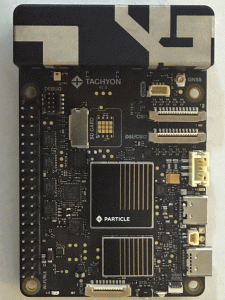
NOTE: In the video at the end of the post, I mentioned, by default, you get 2GB/month data transfer for prototyping but I’m seeing documentation that states otherwise. I’ll be doing some due diligence to confirm what amount of cellular data transfer is available by default and what additional data plans are available. I’ll report back soon with more information. (July 3, 2025)
On July 31, 2024, I decided to back a Kickstarter project from a company named Particle. Their product was / is named the Tachyon. It’s a single-board computer (SBC) in the same vein as the Raspberry Pi 3 / 4 / 5. What caught my eye, at the time, was the built-in 5G connectivity. This came at the right time as I had already spent months researching mobile connectivity using the standard carriers for IoT projects and, let’s just say, it was abysmal. It was the most basic of coverages and the options I was actually testing were still in their very early stages of development. I was looking at, maybe, 500 MB data transfer per month and, even at the end of the testing period, no real answers as to where they were planning to go. I also didn’t see a good rollout for IoT developer from the major carriers and that rollout was quite slow, to say the least. At the time, I felt this to be one of the biggest deterrents to getting more advanced IoT products into the wild.
Then the Particle kickstarter came along and showed so much promise. Not only were they bringing cellular connectivity but also much of what you would expect from a mobile platform / device and they have only expanded on their feature offerings to open the options for other SBCs, not just their own, which shows their commitment to investing in the IoT / edge device community. I’ll talk more about that in a bit.
The items that came in my order were the Tachyon, of course, along with a single-cell 1000mAh LiPO (which everyone received), an audio board (which I believe everyone received), a GNSS antennae, a USB-C power supply with various outlet adapters, a 3-cell 9300mAh LiPO, and a PIMORONI NVMe expansion board labeled for the Raspberry Pi 5 which works with the PCIe connector.
The Tachyon is built on Qualcomm’s Dragonwing product line that is positioned for industrial and IoT applications. If I’m remembering the Spectra 2024 conference correctly, and based on specs, the Tachyon is utilizing the Q5 series of the Dragonwing line. It comes with GPU and 12 TOPS NPU, 8GB RAM, 128GB UFS, secure boot, encrypted filesystem, BLE 5.2, WiFi 6E, and an SD slot. The Tachyon comes in 2 versions specific to cellular connectivity which is North American and “rest of the world” / global. It also has a number of connectors which include: debug, SparkFun QWIIC / Adafruit STEMMA QT, LiPO battery, RTC / coin-battery, 2 CSI with 1 supporting DSI, 2 USB-C with one supporting DP / PD, and 1 PCIe.
The operating system is stored on the 128GB UFS and, I believe, defaults to a customized Qualcomm / Particle image of Ubuntu 24.04 in headless mode. I’m not the Ubuntu expert yet so I don’t know if that’s Desktop or Server. I say this based on information I found as, in my mind, I would have thought Core 24 as the starting point for a customized OS build, which is why I’m not an expert. I’m also making an assumption on it being Ubuntu 24.04 based on a video I saw from an early unboxing but looking at some Particle Documentation, I’m not sure that 24.04 supports all the hardware features yet. It may just be a case of the documentation not being current. The documentation I’m referring to is located at https://developer.particle.io/tachyon/software/application-variants. According to Qualcomm, that documentation may be accurate as I don’t think Ubuntu 24.04 Desktop / Server has been certified on the Dragonwing line, as of this writing, but is scheduled for Q2 which is at an end.
Some other features of the Tachyon include thermal management that throttles processor speeds to minimize heat generation, a backplate on the bottom of the board to act as a heat spreader, and power management features. The power management features include powering from solar panel(s), low-power mode, and an API that allows for control over charging and other features.
The more time I have had to look over the Tachyon, the more I see the thought that went into designing this board. For the longest time, I saw the SBC landscape as less of a prototyping playground and more of a use it and go scenario, however, as I’ve been working on prototyping actual products, my mindset has changed. I was obviously naive to an extent but also there is a space for that, that is where your constraints don’t require you to worry about the extra things that aren’t being used. I might be overthinking things but I don’t think I’m in that realm anymore.
Over the last 12 months, my constraints have forced me into a position where I decided PCB design was something I would need to learn and do, which is exciting but also daunting. Because of those constraints and, now that I have the Tachyon in my hands, I can see the choices the team at Particle made from their years of experience in embedded systems design, IoT, and edge devices. Maybe I’m being presumptive but it seems to me they made very smart choices. It may not all have been about size and mass / weight constraints that some of us find ourselves in but I have to imagine it was at least a part of their calculus. I believe trying to add so many necessary features that are wanted and needed today into a Raspberry Pi form-factor guided their choices also. I also don’t want to take away from the other reasons that had to come to mind for them.
Some of these items that, at least in my realm, are superfluous include the HDMI connector, the ethernet connector, and all the USB-A connectors. I think those can be great in a development board but when we have USB-C and USB hubs that support HDMI, ethernet, and expand our USB connections, it becomes a liability in size and mass / weight constrained environments. This is, at least as much as my brain can fathom, a small subset of designers / developers which have those requirements and I just happen to be in that pool. It’s not to say I won’t still be doing PCB design and development but this device gets me so much closer to the finish line. (Sensor design will definitely require PCB work.)
Let’s compare the mass / weight of the Tachyon and the Raspberry Pi 5 in all it’s configurations:
| Board Setup | Weight / Mass |
| Tachyon | 54g |
| Raspberry Pi 5 | 45g |
| Raspberry Pi 5 with AI HAT | 61g |
| Raspberry Pi 5 with AI HAT and M-HAT | > 61g (M-HAT isn’t released) |
The Tachyon gives me the processing power of the Raspberry Pi 5, along with the ability to perform inferencing with the AI accelerator, and cellular connectivity in just 54 grams and a slightly smaller footprint. The Raspberry Pi 5 requires the additional AI HAT and the future M-HAT from Particle for the cellular connectivity. My guess is, it would get us somewhere between 65g and 70g in total for the Raspberry Pi 5 to achieve the same configuration (don’t forget the additional headers and risers). It may not seem like a lot but it really depends on the scenario.
The most obvious example where mass / weight is important is flight. Increased weight / mass means less flight time. There are also situations where size is important so you want to include all the features you need to get the job done while also minimizing size and mass / weight to effectively achieve the intended goals. Once you start adding sensors, motors, and other hardware, decisions can force you to miss the target. I would say I’m dealing with an extreme case but I believe the team at Particle really thought about what is the minimum viable product (MVP) that can fulfill the needs of most people in IoT / edge device space and I think they did an amazing job.
Here’s a video of the unboxing from the YouTube channel:
